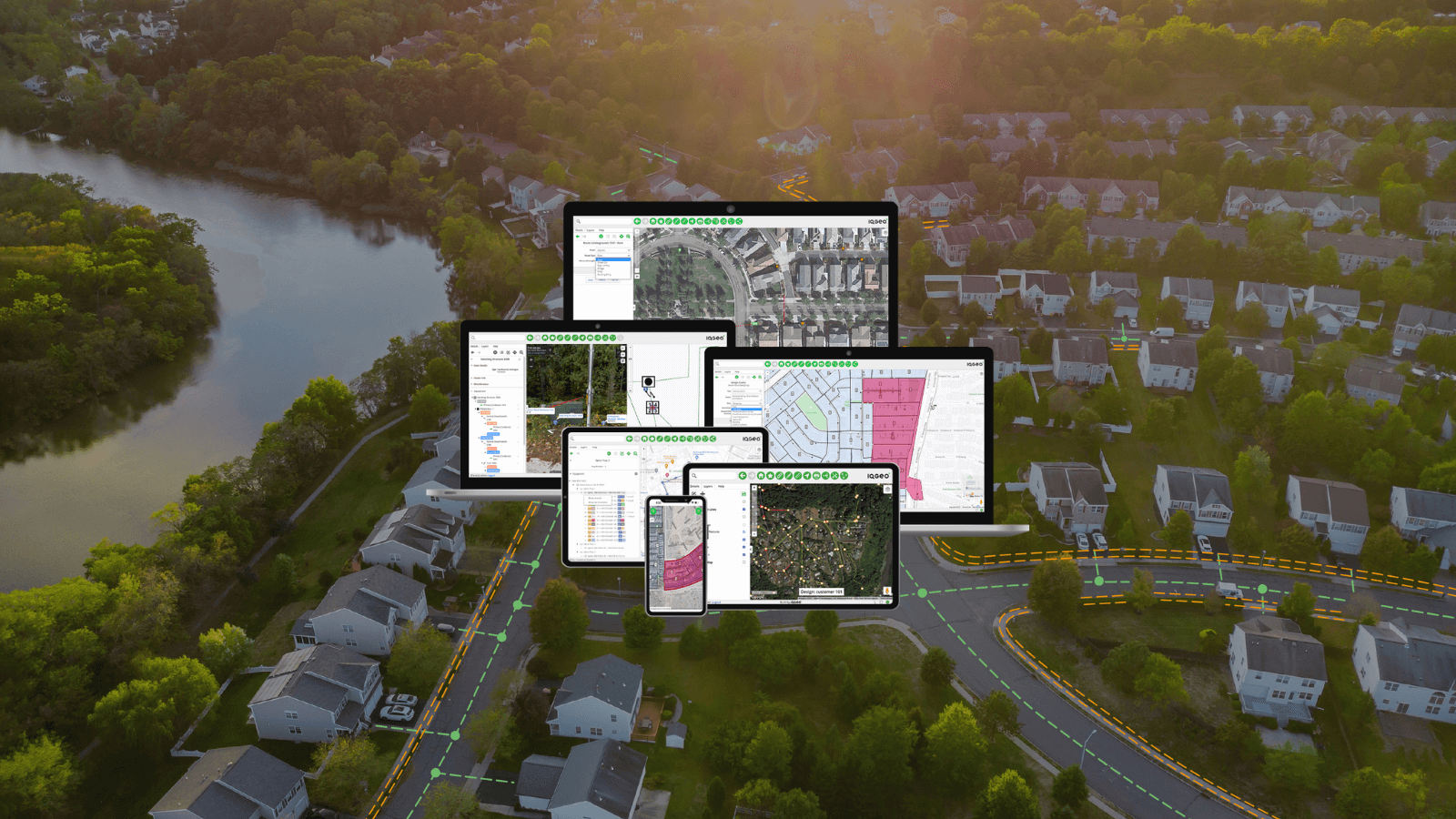Electric utilities are experiencing a major transition, with decarbonization, decentralization, digitization, democratization, and resiliency all driving significant changes to the grid.
These challenges have been building for years:
-
Growing complexity to the grid
-
Steady increases in the volume of work
-
Maintaining grid reliability
-
Reduction in the skilled workforce
-
Data inaccuracies across the organization
As a result, the electric grid and supporting systems require a major overhaul, since current systems and processes are simply not equipped to deliver such monumental change. To be successful, utilities will need flexible and adaptive solutions that can manage the entire lifecycle of the grid while also leveraging the investment in current systems.
Transforming electric network management with IQGeo Adaptive Grid
IQGeo Adaptive Grid is a new approach to managing the entire lifecycle of the electric grid. Our game-changing solution integrates a utility’s network information into a comprehensive network digital twin that digitizes common workflows between the office and the field. From rapid design to inspections to outage restoration, Adaptive Grid can work with existing IT infrastructure to transform every work process.
How IQGeo Adaptive Grid can activate legacy GIS
The traditional approach to managing the network has been through GIS and layered applications. The path forward to manage major changes to the grid doesn’t have to be replacing these existing systems; rather, Adaptive Grid complements the existing GIS, activating geospatial data across the network lifecycle and across the enterprise, enabling teams to execute their work more effectively.

With Adaptive Grid, electric utilities can avoid some of the challenges they have typically experienced with legacy systems:
-
Lack of data accessibility
GIS is a predominantly back-office application that places an enormous burden on the GIS experts to act as data providers across the entire organization instead of data curators. At the same time, field crews don’t have the user-friendly tools to access and contribute to evolving network data.
-
Data inaccuracy and latency
Data accuracy is a major challenge for almost every utility. Additionally, there can be a lag between work performed in the field and manual updates to back-office applications.
-
Inefficient processes
Manual processes still exist throughout the industry, and GIS experts have the challenge to keep the the system of record up to date and resolve data errors. This same problem exists for field teams, who edit paper maps and deliver their updates manually. As a result, planning and operations can be very labor-intensive and frequently encounter backlogs that strangle efficiency, causing project delays and cost overruns.
-
Costly applications and systems
Nearly every utility has multiple stacked applications, which burdens IT teams, increases technical debt, and stifles technology evolution. This becomes even more problematic as utilities face increasing regulatory pressure to reduce O&M costs while changes to the grid require them to innovate.
What Adaptive Grid means for your team?
IQGeo Adaptive Grid reimagines grid modernization and management with an integrated lifecycle approach. The end-to-end capabilities of our solution enable utilities to:
-
Have an accurate, comprehensive view of the network
Adaptive approach to modeling any grid asset – including behind-the-meter assets, complex assemblies such as underground vaults, overhead assemblies, or multi-wire circuits on a pole.
-
Accelerate digital transformation
Only Adaptive Grid provides the agility and usability to transform every team’s productivity through a single solution that eliminates manual and paper processes. At the same time, you won’t need to replace existing systems such as GIS or EAM.
-
Improve data accuracy
From the office to the field, Adaptive Grid gives every team instant access to current network data along with the ability to quickly update it. By removing manual steps, IQGeo Adaptive Grid reduces the risk of human error.
-
Maintain better situational awareness
Adaptive Grid easily integrates with existing systems, combining OT and IT data to provide a single, trusted view of the network. This capability enables fast operational decisions across the network lifecycle.
-
Deliver higher organizational productivity
By digitizing every workflow, users can streamline processes, save time, and manage more work. Users can introduce new applications and create new workflows in a matter of days, and the workflows are available on any device, online or offline.
-
Remove complexity
Our solution also delivers ease of use – a component that is often overlooked until too late in the workflow re-engineering process – which drives high adoption across the enterprise, further streamlining work execution.
-
Adapt to changing business needs
The open architecture of Adaptive Grid enables utilities to seamlessly integrate new data and rapidly build new business rules and workflows. You may not know the future, but you can quickly respond to changes, whether you need interactive smart forms or seamless map integrations.

We’ve seen our integrated approach work effectively across the lifecycle of the electric grid. Some of these use cases include:
-
System planning
Engineers can review historical performance data, overlaid in the as-built network, to identify under-performing circuits, as well as running simulation models against varying levels of DER and EV penetration.
-
Operations
Field crews log-in to their iPads and start to work through their assigned work orders. They have the same view as the team in the back office, who are orchestrating work and monitoring progress. As work is completed in the field, updates are automatically applied to the network and status updated to managers.
-
Outage response
These processes are now enhanced by a single tool and network view to manage one-offs on blue sky days, as well as preparing for storms and responding to disasters. Special training for storm days is minimized, and any necessary recovery work and materials can be communicated in real time.
The time is now!
For years, utilities have been under-served by technology providers who have been resistant to change and continue to be slow to innovate. There is simply no ROI for a utility to replace an existing system with a like-for-like replacement that contains the same fundamental shortcomings. The days of large waterfall IT projects are behind us, and for solutions to add value to utilities they need to be agile and flexible throughout their lifecycle.
Utilities understand these challenges. However, industry giants continue to push you to replace current GIS and supporting applications with a system that adds no real additional value and will cost millions of dollars. But there is an alternative: keep the existing GIS and build a digital twin with digital workflows around it. This approach simply requires a new mindset.

The auto industry is a perfect example. For many decades, consumers were marketed traditional, gas-powered vehicles as their only choice. Then Tesla came along. In less than 20 years, the electric vehicles have a phenomenal growth trajectory. And Tesla hasn’t only dramatically changed the fuel source. They’ve also fundamentally changed what consumers think is possible for the driving experience, from easy-to-use, Apple-like interfaces to seamless software updates to autonomous driving. In the process, they’ve gone from upstarts to being imitated by the largest automakers in the world. They are the face of auto innovation.
Without reimagining current systems and business processes, decarbonization simply isn’t possible. IQGeo’s Adaptive Grid gives you open-source technology, built upon cloud-first and mobile-first principles, that enables rapid deployment and adoption by all users. With this new approach to network lifecycle management, you’ll have the adaptive technology strategy you need to keep pace with the enormous challenge of grid modernization.
To learn more about what makes a network digital twin adaptable for the future, schedule a demo with our industry experts.
Webinar: From staking and design to asset inspections: digitalizing network model workflows.
Discover the quickest route to modernize your electric grid.
Watch the webinar to see how digitalization transforms common workflows, whether you're in the design, construction, or maintenance stage of your grid, IQGeo offers a seamless solution to manage your network model through a single, user-friendly platform, regardless of your GIS.

Vice President of Utility Solutions, IQGeo
Similar articles:



 Previous
Previous







